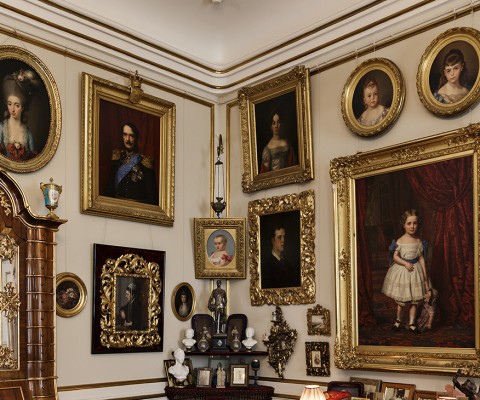Portraits of royal children
The museum presents the history of the Royal Family during the last 150 years. Queen Louise’s private salon in particular displays the characteristics of a teeming family life, with many portraits on the walls.
Christian IX and Queen Louise were from 1863 Denmark’s Royal Couple and initiated the House of Glücksburg. Even in their own time they were known as “Europe’s parents-in-law”, as all of their six children married into European royal houses.
The family’s life was, however, relatively humble, and in many ways resembled that of the bourgeoisie rather than Europe’s rulers. Prince Christian and Louise of Hesse-Kassel were married in 1842, but it was only 10 years later that the decision was taken that they would be the heirs to the throne of the childless Frederik VII, their relative. For many years the family lived in The Yellow Palace next to Amalienborg, and the marriage was a happy one. The family was a close one, and the childrens’ upbringing was characterised by domestic and bourgeois values.
Queen Louise was artistically gifted, and there are several paintings of flowers by her in the collection. The queen was also an acquaintance of the artist Elisabeth Jerichau Baumann (1819-81), who painted portraits of many royal personages in Europe, presumably on the strength of Queen Louise’s introductions. Baumann was also the artist behind the double portrait of the Princesses Alexandra and Dagmar, as well as the portrait of Prince Frederik, while the artist August Schiøtt (1823-95) painted two portraits, of Princess Thyra and Prince Vilhelm.
Both Baumann and Schiøtt were well known artists in their time, and it was only natural for a family which was to inherit the throne and found a dynasty to have portraits painted of its children. This is clearly seen in the depiction of the heir to the throne Prince Frederik, which has an official and magisterial look, while the pictures of the daughters and the younger son are closer to the private sphere.
In 1886 the Royal Couple had themselves preserved for eternity along with their children, children-in-law, and grand-children by Lauritz Tuxen at Fredensborg Palace. Even though the family was spread over great geographic distances, they often succeeded in meeting at the palace in the summer for the so-called “Fredensbog Days”. The original hangs in Christiansborg, while a smaller reproduction can be seen at the Amalienborg Museum.
 Dansk
Dansk
 English
English
 Deutsch
Deutsch

